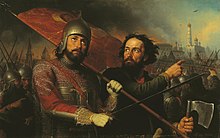Battle of Moscow (1612)
| Battle of Moscow | |||||||
|---|---|---|---|---|---|---|---|
| Part of Moscow Kremlin to Prince Pozharsky by Ernst Lissner | |||||||
| |||||||
| Belligerents | |||||||
|
|
| ||||||
| Commanders and leaders | |||||||
| Jan Karol Chodkiewicz | Dmitry Pozharsky | ||||||
| Strength | |||||||
|
12,000 relief army 3,000 in Moscow |
8,000 Russians 2,500 Cossacks | ||||||
| Casualties and losses | |||||||
| 1,500 | 1,500 | ||||||

The Battle of Moscow was a series of two battles, which took place in
Prelude
After the Battle of Klushino in summer of 1610, Tsar Vasili IV of Russia was deposed and taken to Warsaw. The Polish-Lithuanian army entered Moscow on September 21, 1610, and the boyars, clergy, and citizens of Moscow, in fear of False Dmitry II, accepted the Polish Prince Wladyslaw IV Vasa as new Tsar.[1]
But the foreign Tsar was not universally accepted outside Moscow, and the country was ransacked by Poles, mercenaries, and gangs of robbers.
In March 1611, citizens of Moscow rebelled against the Poles, and the Polish garrison was besieged in the
Amidst anarchy and breakdown of the central government, citizens of

First Battle
On September 1, 1612, Polish–Lithuanian forces unsuccessfully tried to break the siege of the
Second Battle
On September 3 Chodkiewicz decided to attack Moscow via its southern suburb, the Zamoskvorechye District. Some 600 Hungarian infantrymen managed to reach the walls of the Kremlin. They were followed by main Commonwealth units, which however were halted in the narrow streets of the district. After a Russian counterattack, Chodkiewicz ordered a retreat, losing several hundred men.
Outcome
Chodkiewicz's August advance was met with failure, as was King Sigismund's invasion, when he was stopped in November, less than 90 kilometres (56 mi) from Moscow. According to Dunning, "On October 26, Mstislavskii... led Ivan Romanov, Mikhail Romanov, and other sheepish aristocrats out of the Kremlin. The next day, October 27, the Polish garrison surrendered unconditionally, and national militia forces entered the capital."[4]
References
Sources
- Andrusiewicz, Andrzej (1990). Dzieje Dymitriad 1602–1614. t. I, II, Warszawa.
- Bohun, Tomasz (2005). Moskwa 1612. Wydawnictwo Bellona. ISBN 83-11-10644-4.
